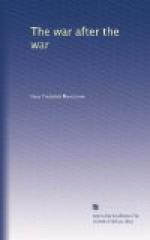To English pride this was a terrific jolt. I happened to be in England at the time and I recall the astonishment of no less a distinguished individual than the Chancellor of the British Exchequer. It was unbelievable that any nation could demand greater security than the good name of the Empire. “If the elder J. P. Morgan were alive this would never have happened,” said the London bankers. They knew that the Grizzled Old Lion of American Finance always held that character was the best collateral. In the war emergency, however, many American bankers thought to the contrary and the net result was that with all external loans thereafter England and France have been forced to dig into their strong boxes and do what any individual does when he borrows money—put up a good margin of security.
An illustration of this secured obligation of the British Government is the issue of $300,000,000 Five and a Half Per Cent Gold Notes dated November 1, 1916. Principal and interest are payable without deduction of any English tax in New York and in United States gold coin. The holder of these notes, however, has the option to get his money in London but at a fixed rate of $4.86 per pound sterling, the normal value of the pound in peace time. Since the pound sterling at the time this article is written is quoted at $4.76, this is a decided advantage.
The new English loan is secured by stocks and bonds whose total market value is not less than $360,000,000. One group of this collateral consists of stocks, bonds and other obligations of American corporations and the obligation, either as maker or guarantor, of the Government of the Dominion of Canada, the Colony of Newfoundland and Canadian Provinces and Municipalities. The second group included obligations of Australia, Union of South Africa, New Zealand, Argentina, Chili, Cuba, Japan, Egypt, India and a group of English Railway Companies. I enumerate this collateral to show the inroads upon British securities that increasing war cost is making. This collateral must always show a market value margin of twenty per cent above the amount of the loan. It means that should there be any slump the English Government must supply additional security.
This issue was brought out in two forms. Half of the loan is in Three Year Notes due November 1, 1919, which were issued at 991/4 and interest and yielding over 5.75 per cent: the other half is in Five1/4 Year Notes due November 1, 1921, brought out at 981/2 and interest and yielding about 5.85 per cent. These Notes are redeemable at the option of the Government at various interest dates between 1917 and 1920 at prices ranging from 101 to 105 and interest.
Having established the precedent of a secured loan, all succeeding English issues in this country have been backed up with ample collateral. These bonds have a ready market, an important detail that the investor must not overlook in purchasing foreign securities.




